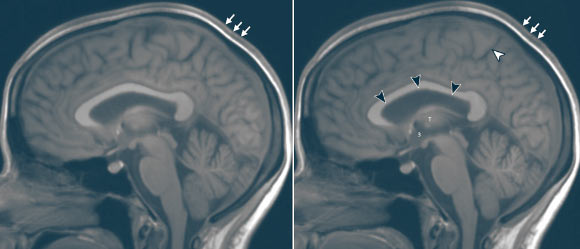Study: Long-Duration Spaceflight Affects Brain Volume | Neuroscience, Space Exploration – Sci-News.com
A new study led by Professor Larry Kramer from the University of Texas Health Science Center at Houston suggests that the impact of microgravity is far-reaching, potentially causing brain volume changes and pituitary gland deformation.

Reconstructed sagittal 5-mm orthogonal midline images in the brain using the sagittal 3D T1-weighted data set: (left) preflight baseline image and (right) matching postflight image (postflight day 1) in the same astronaut; the black arrowheads show upward expansion of the anterior, middle, and posterior superior margins of the lateral ventricle with associated narrowing of the marginal sulcus of the cingulate sulcus (white arrowhead); there is subtle expansion of the third ventricle (indicated by a 3), which has displaced the thalamus (T) from midline, making it less visible; there is thickening of the intermediate signal scalp soft tissues (arrows). Image credit: Kramer et al, doi: 10.1148/radiol.2020191413.
On Earth, the gravitational field creates a hydrostatic gradient, a pressure of fluid that progressively increases from your head down to your feet while standing or sitting. This pressure gradient is not present in space.
“When you’re in microgravity, fluid such as your venous blood no longer pools toward your lower extremities but redistributes headward,” Professor Kramer said.
“That movement of fluid toward your head may be one of the mechanisms causing changes we are observing in the eye and intracranial compartment.”
To find out more, Professor Kramer and his colleagues performed brain MRI on 11 astronauts, including 10 men and one woman, before they traveled to the International Space Station (ISS).
The researchers followed up with MRI studies a day after the astronauts returned, and then at several intervals throughout the ensuing year.
MRI results showed that the long-duration microgravity exposure caused expansions in the astronauts’ combined brain and cerebrospinal fluid (CSF) volumes. CSF is the fluid that flows in and around the hollow spaces of the brain and spinal cord.
The combined volumes remained elevated at one-year postflight, suggesting permanent alteration.
“What we identified that no one has really identified before is that there is a significant increase of volume in the brain’s white matter from preflight to postflight,” Professor Kramer said.
“White matter expansion in fact is responsible for the largest increase in combined brain and cerebrospinal fluid volumes postflight.”
MRI also showed alterations to the pituitary gland, a pea-sized structure at the base of the skull often referred to as the ‘master gland’ because it governs the function of many other glands in the body.
Most of the astronauts had MRI evidence of pituitary gland deformation suggesting elevated intracranial pressure during spaceflight.
“We found that the pituitary gland loses height and is smaller postflight than it was preflight,” Professor Kramer said.
“In addition, the dome of the pituitary gland is predominantly convex in astronauts without prior exposure to microgravity but showed evidence of flattening or concavity postflight. This type of deformation is consistent with exposure to elevated intracranial pressures.”
The team also observed a postflight increase in volume, on average, in the astronauts’ lateral ventricles, spaces in the brain that contain CSF. However, the overall resulting volume would not be considered outside the range of healthy adults.
The changes were similar to those that occur in people who have spent long periods of bed rest with their heads tilted slightly downward in research studies simulating headward fluid shift in microgravity.
Additionally, there was increased velocity of CSF flow through the cerebral aqueduct, a narrow channel that connects the ventricles in the brain.
A similar phenomenon has been seen in normal pressure hydrocephalus, a condition in which the ventricles in the brain are abnormally enlarged. Symptoms of this condition include difficulty walking, bladder control problems and dementia. To date, these symptoms have not been reported in astronauts after space travel.
The findings were published in the journal Radiology.
_____
Larry A. Kramer et al. Intracranial Effects of Microgravity: A Prospective Longitudinal MRI Study. Radiology, published online April 14, 2020; doi: 10.1148/radiol.2020191413






